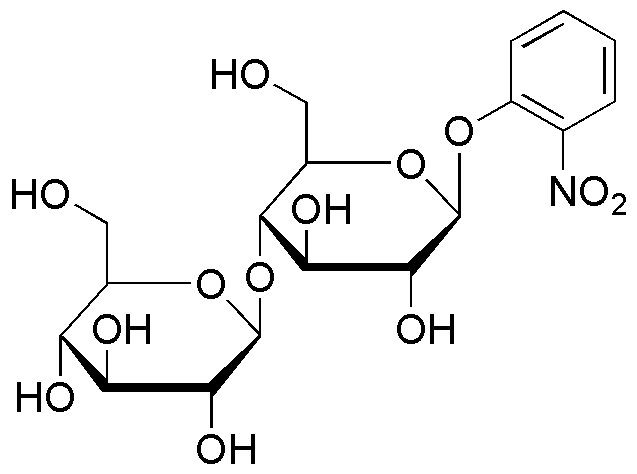O-Nitrophenyl b-D-cellobioside is widely utilized in research focused on:
- Enzyme Activity Assays: This compound serves as a substrate for various glycosidases, allowing researchers to study enzyme kinetics and mechanisms in carbohydrate metabolism.
- Cellulose Research: It is used in studies related to cellulose degradation, helping scientists understand the interactions between enzymes and cellulose substrates, which is crucial for biofuel production.
- Biotechnology Applications: In the development of genetically modified organisms, this compound can be used to assess the expression of genes involved in carbohydrate processing.
- Analytical Chemistry: It is employed in chromatographic techniques to analyze glycosidic bonds in polysaccharides, providing insights into carbohydrate structure and function.
- Pharmaceutical Research: The compound is useful in drug formulation studies where carbohydrate-based drugs are developed, enhancing the understanding of drug interactions and bioavailability.
General Information
Properties
Safety and Regulations
Applications
O-Nitrophenyl b-D-cellobioside is widely utilized in research focused on:
- Enzyme Activity Assays: This compound serves as a substrate for various glycosidases, allowing researchers to study enzyme kinetics and mechanisms in carbohydrate metabolism.
- Cellulose Research: It is used in studies related to cellulose degradation, helping scientists understand the interactions between enzymes and cellulose substrates, which is crucial for biofuel production.
- Biotechnology Applications: In the development of genetically modified organisms, this compound can be used to assess the expression of genes involved in carbohydrate processing.
- Analytical Chemistry: It is employed in chromatographic techniques to analyze glycosidic bonds in polysaccharides, providing insights into carbohydrate structure and function.
- Pharmaceutical Research: The compound is useful in drug formulation studies where carbohydrate-based drugs are developed, enhancing the understanding of drug interactions and bioavailability.
Documents
Safety Data Sheets (SDS)
The SDS provides comprehensive safety information on handling, storage, and disposal of the product.
Product Specification (PS)
The PS provides a comprehensive breakdown of the product’s properties, including chemical composition, physical state, purity, and storage requirements. It also details acceptable quality ranges and the product's intended applications.
Certificates of Analysis (COA)
Search for Certificates of Analysis (COA) by entering the products Lot Number. Lot and Batch Numbers can be found on a product’s label following the words ‘Lot’ or ‘Batch’.
*Catalog Number
*Lot Number
Certificates Of Origin (COO)
This COO confirms the country where the product was manufactured, and also details the materials and components used in it and whether it is derived from natural, synthetic, or other specific sources. This certificate may be required for customs, trade, and regulatory compliance.
*Catalog Number
*Lot Number
Safety Data Sheets (SDS)
The SDS provides comprehensive safety information on handling, storage, and disposal of the product.
DownloadProduct Specification (PS)
The PS provides a comprehensive breakdown of the product’s properties, including chemical composition, physical state, purity, and storage requirements. It also details acceptable quality ranges and the product's intended applications.
DownloadCertificates of Analysis (COA)
Search for Certificates of Analysis (COA) by entering the products Lot Number. Lot and Batch Numbers can be found on a product’s label following the words ‘Lot’ or ‘Batch’.
*Catalog Number
*Lot Number
Certificates Of Origin (COO)
This COO confirms the country where the product was manufactured, and also details the materials and components used in it and whether it is derived from natural, synthetic, or other specific sources. This certificate may be required for customs, trade, and regulatory compliance.


